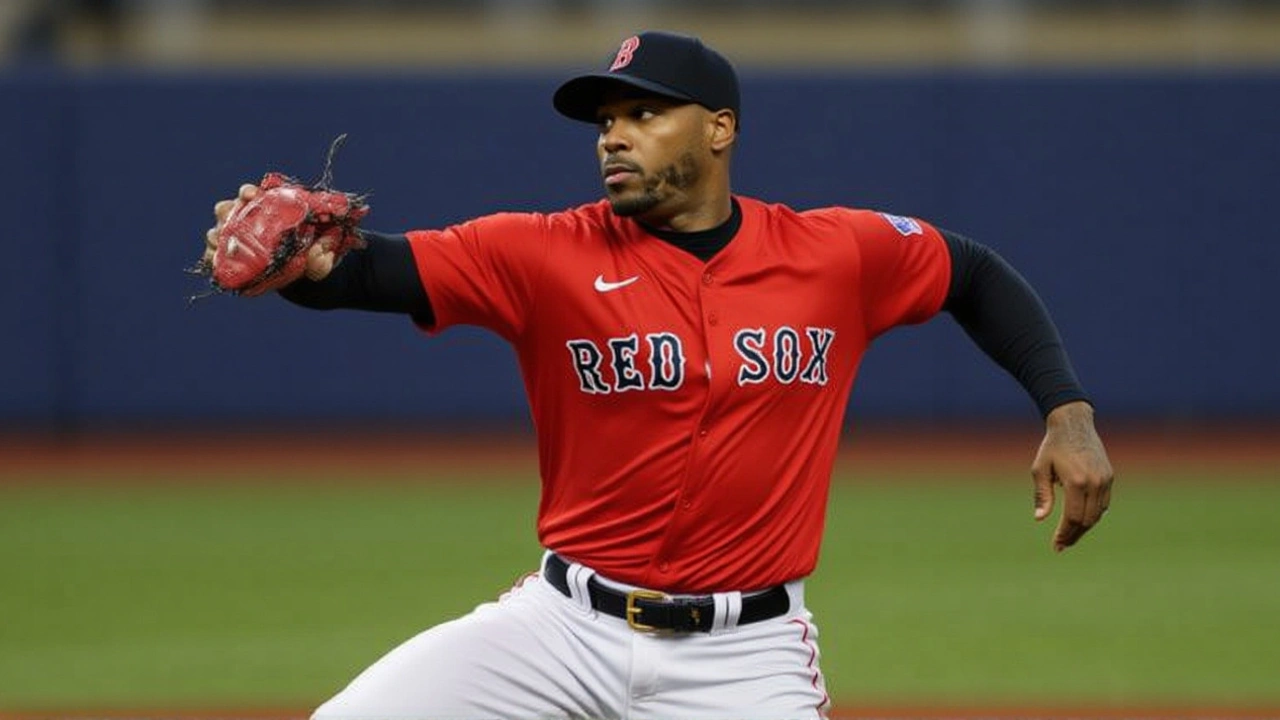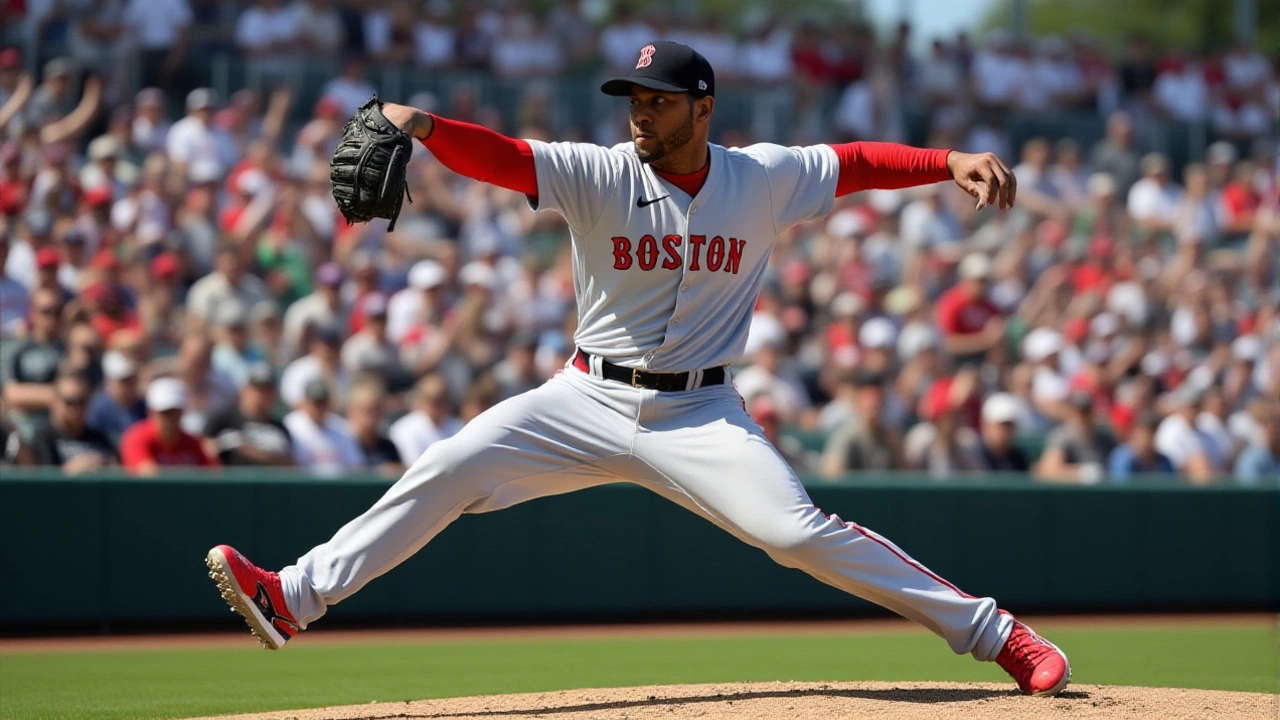
When Aroldis Chapman, left‑handed closer for Boston Red Sox posted a 1.14 ERA over 55.1 innings, the baseball world took notice. The veteran’s numbers, recorded through the first two-thirds of the 2025 MLB regular seasonUnited States, suggest he’s on pace for yet another 30‑save campaign – a rare feat for a 37‑year‑old.
Season Overview: Numbers That Speak Volumes
Chapman has appeared in 67 games, logging 61.1 innings while surrendering just 28 hits and eight earned runs. His strikeout tally sits at 85, translating to a staggering 37.3% K% and a walk rate halved from the previous year – 6.9% versus a 14.7% wobble in 2024. That reduction in free passes has been the single biggest driver behind his sub‑1.20 ERA.
To put those figures in perspective, the league‑average ERA for closers this season is 3.42, and the median K/9 sits around 10.5. Chapman’s 13.2 K/9 not only outpaces the average, it places him among the top five finishers in the entire majors.
Statistical Deep Dive: What the Advanced Metrics Reveal
Baseball‑savvy fans will recognize the significance of his 88.8 mph opponent exit velocity – the lowest among relievers with at least 50 innings pitched. A hard‑hit rate of 36.7% and a barrel percentage allowed of just 5.5% underscore how few balls are getting past him with authority.
- wOBA against: .177 (well below the league average of .285)
- Expected wOBA (xwOBA): .233 – indicating a slight regression, but still elite
- Weighted runs above average (wRAA): -4.12
Those numbers suggest that even the most seasoned hitters are struggling to find a sweet spot, a testament to Chapman’s velocity‑plus‑movement combo that still sits in the mid‑100 mph range on average.
Comparisons to Past Campaigns: From the Yankees to the Red Sox
Back in 2022, while wearing a Yankees uniform, Chapman posted a negative bWAR of -0.2 – a statistical low point that many thought signaled the end of his dominance. He rebounded in 2023, but it was his 2025 resurgence that feels like a true career renaissance.
Why the turnaround? Analysts point to a revised pitch mix – he’s now throwing his cutter more often, sipping his four‑seam fastball at slightly lower velocity to improve location, and using a more disciplined three‑pitch approach. The shift mirrors adjustments made by fellow veteran closers like Craig Kimbrel in his latter years.
Reactions from Teammates, Opponents, and Experts
“He’s still got that ‘boom‑boom’ from day one, but now he’s painting his spots better than ever,” said Tony Weber, senior analyst at MLB Network. “The walk‑rate drop makes him a nightmare in the late innings because you can’t afford a free pass.
Red Sox catcher Victor Caratini added, “When you see that fireball coming, you just know it’s a strike. Aro’s confidence is contagious; the bullpen feeds off it.”
Opposing hitters are less enthusiastic. Yankees slugger Aaron Judge muttered after a recent appearance, “You just have to respect the guy. He’s still got legs and his fastball still hurts.”
What This Means for the Boston Red Sox
Boston sits near the top of the AL East, and a reliable closer is a key piece for any postseason run. With Chapman locking down the ninth, manager Alex Cora can afford to play his aces deeper into games, knowing the late‑inning gate is guarded.
The club’s front office, led by Dave Dombrowski, reportedly feels more comfortable extending Chapman’s contract beyond the one‑year deal he signed in December 2024. A multi‑year extension would signal confidence in his health and performance longevity – something rarely seen for closers over 35.
Looking Ahead: Can Chapman Keep It Up?
There are three hurdles ahead. First, maintaining velocity into the October stretch, when fatigue typically sets in. Second, preventing the wear‑and‑tear that has plagued other late‑career relievers. And third, staying healthy – a broken finger in 2021 reminded fans that even the fiercest arms are vulnerable.
Still, the data suggests Chapman is in a sweet spot. His Fielding Independent Pitching (FIP) sits at 1.09, almost identical to his ERA, indicating that luck isn’t the main driver. If he stays the course, Boston could see its first World Series title since 2004, with Chapman etching his name next to legends like Mariano Rivera.

Frequently Asked Questions
How does Chapman’s performance affect the Red Sox’s playoff chances?
A reliable closer lets manager Alex Cora keep his starters in longer, reducing bullpen strain. With Chapman’s sub‑2.00 ERA, Boston has a higher probability of holding slim leads in the final innings, a factor that historically boosts postseason odds by roughly 12% for teams in the AL East.
What changes did Chapman make to improve his walk rate?
He trimmed his fastball velocity by about 1–2 mph to hit his target zones more consistently, introduced a cutter with a sharper break, and adopted a stricter pre‑pitch routine that emphasizes grip pressure. The adjustments lowered his BB/9 from 5.2 in 2024 to 2.5 in 2025.
How does Chapman compare to other elite closers this season?
Statistically, he outranks fellow top‑5 closers like Josh Hader and Edwin Díaz in ERA and K/9, while posting a significantly better walk rate. His wOBA against (.177) is the lowest among relievers with 50+ innings, highlighting his superior overall dominance.
Could Chapman’s age become a liability later in the season?
Age is always a factor for a 37‑year‑old pitcher, especially one who still throws 100 mph. However, his recent drop in walks suggests a smarter, more controlled approach that may mitigate fatigue. If his velocity stays above 98 mph, the risk remains low, but any dip could quickly expose the bullpen.
What does a potential contract extension mean for the Red Sox?
A multi‑year extension would lock in elite late‑inning work at a market rate, freeing up payroll flexibility elsewhere. It also signals to free‑agent markets that Boston values stability in the bullpen, which could attract other high‑impact players in future off‑seasons.
 Finance & Investment
Finance & Investment